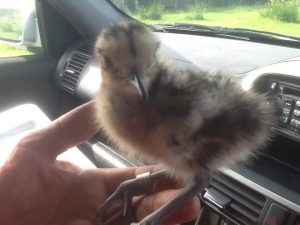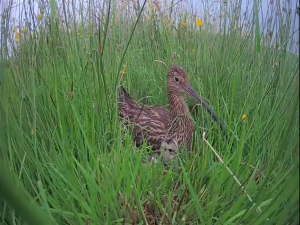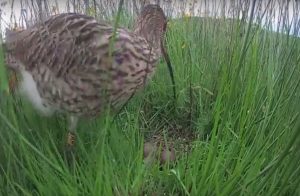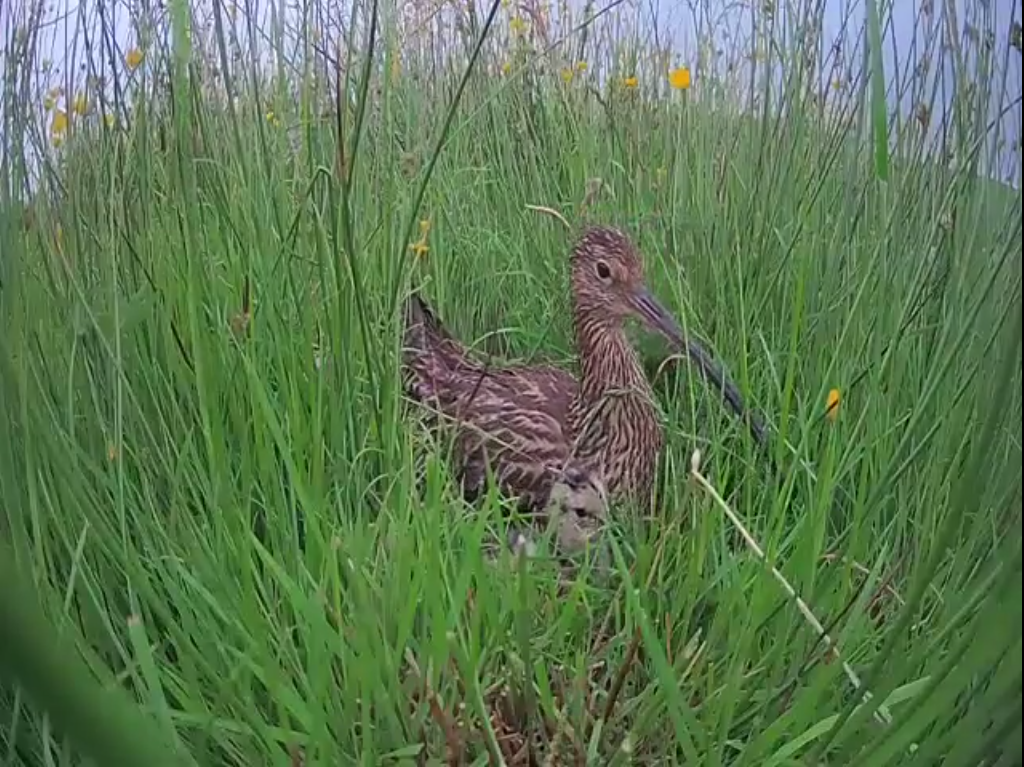The Fortunes and Misfortunes of the Curlew Cam Family – by Amanda Perkins, Project Manager
Thank you to all of you who engaged in the Curlew Cam journey to see the hatching of chicks. Many of you said it was rather too distracting and in fact it was so distracting for us, that we had turned it off at the moment that all the action started and the chicks and adults were calling to one another even before the chicks had hatched. We were soon alerted to the imminent hatching event by several of you who contacted us either to tell us or ask us what was going on. Inevitably we have been receiving enquiries about the fate of the chicks.
in fact it was so distracting for us, that we had turned it off at the moment that all the action started and the chicks and adults were calling to one another even before the chicks had hatched. We were soon alerted to the imminent hatching event by several of you who contacted us either to tell us or ask us what was going on. Inevitably we have been receiving enquiries about the fate of the chicks.
It was David Tompkins, the ornithological assistant during the 2016 nesting season, who suggested that Curlew Cam could be a good thing in terms of raising awareness of the plight of curlew. We thought it a good idea, but had not anticipated just how interesting it would be for us and other curlew projects to witness the hatching behaviour of both adults and chicks. It immediately put us in contact with some international curlew projects and started a flow of information about curlew. We were alarmed in the office at how noisy the birds were and concerned that predators would immediately be alerted to the nest site and brood.
 There was a point when we had ordered the Curlew Cam, but not been able to put it up. The right nest site had to be found with good transmission signal which limited the choices. We had permission from a local farmer, on whose land a pair of birds regularly nest in the same field each year, to transmit through his internet connection in the house. We always try to minimise nest disturbance so planned to put the camera in when we were putting up the fence. The protective electric fences, sponsored by Rappa, are not put up until the female has laid a full clutch of eggs. There is a gap of one or two days before each egg is laid, and disturbing them before the full clutch is complete could result in desertion.
There was a point when we had ordered the Curlew Cam, but not been able to put it up. The right nest site had to be found with good transmission signal which limited the choices. We had permission from a local farmer, on whose land a pair of birds regularly nest in the same field each year, to transmit through his internet connection in the house. We always try to minimise nest disturbance so planned to put the camera in when we were putting up the fence. The protective electric fences, sponsored by Rappa, are not put up until the female has laid a full clutch of eggs. There is a gap of one or two days before each egg is laid, and disturbing them before the full clutch is complete could result in desertion.
Carnyx Wild were travelling down from Yorkshire to install the Curlew Cam, so it was important not to give them a wasted journey. We had calculated our timings carefully but wanted to be sure, so checked the nest from a distance the day before the fence and cam were due to go up. Tony, the field ornithologist, could not see a bird sitting or any birds present in the territory. On closer investigation he found that the nest had been predated before a full clutch of eggs had been laid. Disappointment at the loss of a nest was combined with the anxiety of having to find another suitable nest site.
Each year, a handful of the farmers with whom we work find nests. It is not always the same people and the nests are not always in the same sites. A few days after the loss of the nest intended for Curlew Cam, a nearby farmer reported finding a nest while out checking his cattle. Earlier in the season a nest we had been monitoring nearby to this farm had failed at egg stage. We knew that the pair were likely to have a second attempt and had been keeping an eye out for the nest, but had not found it. The nest discovered by the farmer was almost certainly the second nesting attempt of the original pair, just a few fields away from the first site.
When the nest had a full clutch of four eggs, at last Curlew Cam was installed. Co-incidentally this was on a beautiful site with a hill in the background and adorned with buttercups that at least one of the adults spent some time re-arranging on a fairly regular basis.
The story became even more captivating as through the Curlew Cam we were able to read the colour rings on the curlew legs and made an extraordinary connection. The female curlew on our Curlew Cam nest was a bird that had been spotted and rescued by Tony during the course of his work. He had noticed that it had a form of leg paralysis that curlew and other waders can sometimes suffer from. He caught it and took it to a vet before looking after it at home, keeping it in a sling in his office and feeding it mealworms until it recovered the use of its legs. He then released it back to the site where he had found it. Tony had always been anxious about the chances of survival of such a bird obliged to spend time out of its normal habitat, and in a possibly stressful environment. The alternative however would have been to leave the bird to an inevitable natural death. Tony was genuinely excited to see the bird that he had rescued healthily incubating eggs.
 Sadly the fortunes of the chicks were not as good. They were lost and presumed predated within a week. When Tony and I had gone out to ring and radio tag the chicks we had been aware of crows persistently investigating the nest. Curlew Cam viewers will have heard the number of times that the adults made alarm calls to one another and will also have seen them leaving the nest to fend off avian predators. There are known to be many foxes in the vicinity and this site was not in one of our trial lethal fox control areas. Like so many of our radio tags on chicks, they were taken out of signal range, so we could not be sure which species of predator was responsible.
Sadly the fortunes of the chicks were not as good. They were lost and presumed predated within a week. When Tony and I had gone out to ring and radio tag the chicks we had been aware of crows persistently investigating the nest. Curlew Cam viewers will have heard the number of times that the adults made alarm calls to one another and will also have seen them leaving the nest to fend off avian predators. There are known to be many foxes in the vicinity and this site was not in one of our trial lethal fox control areas. Like so many of our radio tags on chicks, they were taken out of signal range, so we could not be sure which species of predator was responsible.
We do re-visit nest sites and observe from a distance, even when the chicks are lost, trying to make sure that we have not overlooked anything. Adult behaviour is usually the biggest clue to nest failure. Following chick loss the adults stay for a while calling and continuing to fend off predators, but increasingly they stray further from the nest, looking for chicks that one of them would usually have been with up until they point that they themselves faced danger from a predator. I am cross with myself that the irrational part of me finds it even harder to accept the loss of chicks than that of losing eggs, but the chicks are very appealing.
This is the first time in three years of active nest monitoring that we have been able to see chicks hatch and survive to fledging. Our interventions of temporary protective electric fencing and lethal fox control have had an influence on this outcome, as in the two previous years of nest monitoring without such interventions no chicks survived. Like other curlew projects we are now at the stage where we need to focus on what is causing the major problems for the chicks and what the chicks need to survive. In the first two years of the project it was incredibly disheartening to lose nest after nest. We now know that we can make a difference and we need to hone that knowledge and capitalise on our experience.

